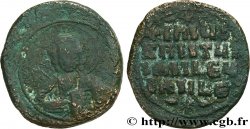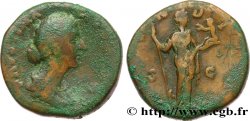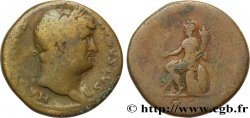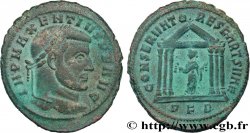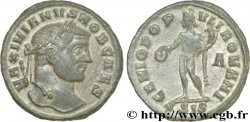v50_0116 - BRIOSSUS VICUS - BRIOUX (Deux-Sèvres) Triens, monétaire GENNASTES
MONNAIES 50 (2011)
Starting price : 2 800.00 €
Estimate : 3 800.00 €
Realised price : 2 800.00 €
Starting price : 2 800.00 €
Estimate : 3 800.00 €
Realised price : 2 800.00 €
Type : Triens, monétaire GENNASTES
Date: (VIIe siècle)
Mint name / Town : Brioux-sur-Boutonne (79)
Metal : gold
Diameter : 12 mm
Orientation dies : 12 h.
Weight : 1,33 g.
Rarity : R3
Coments on the condition:
Très bel exemplaire, sur un flan un peu court, mais avec un avers très ben centré et un revers légèrement décentré sur la partie supérieure droite. Sinon, monnaie de frappe vigoureuse avec un bel aspect un peu mat et une patine de collection
Catalogue references :
Predigree :
Cet exemplaire provient du stock de Ratto, mars 1946
Obverse
Obverse legend : + BRIOSSO VIC.
Obverse description : Buste au double diadème perlé, à droite ; diadème ondulé et relevé à la nuque ; cheveux hérissés ; lèvres en V ; globules semés sur le menton ; épaules en cône tronqué, hachée et losangée ; légende circulaire autour.
Reverse
Reverse legend : + GENNASTIS MO.
Reverse description : Croix chrismée à droite, cantonnée d’un globule au 1er, 3e et 4e cantons ; légende autour.
Commentary
Ce triens correspond exactement au n° 957 du Belfort, proche du B. 956, mais avec trois globules en cantonnement au revers. Le monétaire GENNASTES est représenté par cinq triens différents dans le Belfort (les trois premiers avec cette tête diadémée et les deux derniers avec la tête à l’appendice perlé).
Cet exemplaire est parfaitement identifiable avec de très belles lettres, en bord de flan mais encore restituables.
This triens corresponds exactly to n° 957 of the Belfort, close to B. 956, but with three globules in cantonment on the reverse. The monetary GENNASTES is represented by five different triens in the Belfort (the first three with this diademed head and the last two with the head with the pearly appendage). This example is perfectly identifiable with very beautiful letters, on the edge of the flan but still restorable
Cet exemplaire est parfaitement identifiable avec de très belles lettres, en bord de flan mais encore restituables.
This triens corresponds exactly to n° 957 of the Belfort, close to B. 956, but with three globules in cantonment on the reverse. The monetary GENNASTES is represented by five different triens in the Belfort (the first three with this diademed head and the last two with the head with the pearly appendage). This example is perfectly identifiable with very beautiful letters, on the edge of the flan but still restorable








 Report a mistake
Report a mistake Print the page
Print the page Share my selection
Share my selection Ask a question
Ask a question Consign / sell
Consign / sell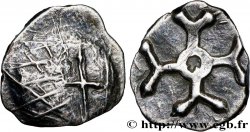
 Full data
Full data